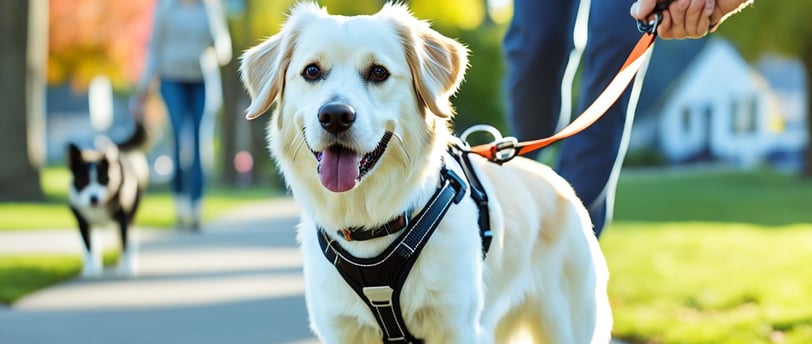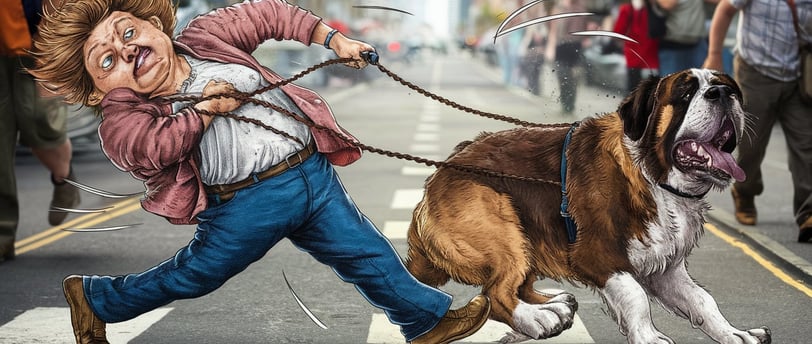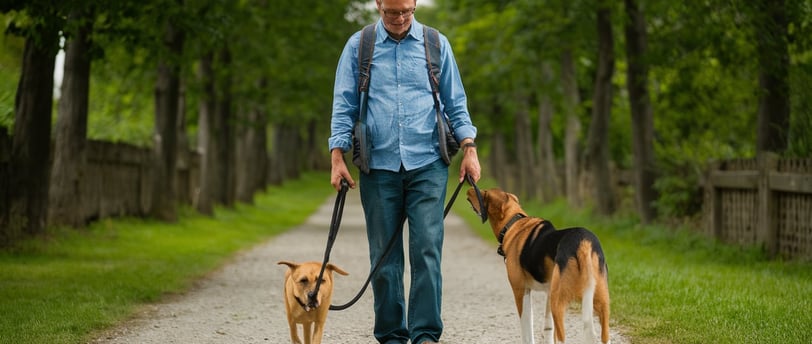Dog pulling training: Effective Training Tips
Tired of being dragged on walks? In "Dog pulling training: Effective Training Tips," discover proven techniques to curb your dog's pulling behavior. This guide offers practical advice, positive reinforcement methods, and step-by-step strategies to transform your walks into enjoyable experiences.
The Cnaine Chronicles
7/19/20244 min read


Imagine a peaceful walk in the park, your dog trotting happily beside you with a loose leash. Now, picture the chaos of a tug-of-war, where your furry friend drags you along.
If your walks feel more like a struggle than a joy, you're not alone!
In this post, we'll share effective training tips to curb your dog's pulling habit.
These tips will help make your strolls enjoyable for both of you. Say goodbye to the chaos and hello to harmony!
Key Takeaways
Leash pulling is a common issue, but there are simple techniques to stop the behavior
The key is to focus on rewarding good leash behavior and never allowing your dog to walk when they are pulling
Consistency and incorporating life rewards can teach your dog to walk calmly by your side
Proper equipment and training foundation are crucial for success
With patience and positive reinforcement, you can transform your dog's leash manners for more enjoyable walks
Understanding Why Dogs Pull on the Leash
Have you ever felt frustrated with a dog who won't walk calmly on a leash? Wondered why they pull? It's because of their natural instincts and behaviors.
Dogs Pull to Get Where They're Going
From a dog's view, the world is full of new things to see, hear, and smell. Being on a leash feels like being held back. So, they pull forward to explore faster. This is more common in energetic breeds or young dogs who don't know how to walk nicely on a leash yet.
Dogs also want to check out people, animals, or things they see on a walk. When they pull on the leash, it's hard to keep a steady pace.
Teaching a dog to walk nicely on a leash takes time, patience, and effort. Make sure your dog gets enough exercise and mental stimulation before training. A happy, well-stimulated dog is more likely to walk calmly.
Reason for Pulling
Explanation
Natural Instinct
Dogs want to explore and get to their destination fast, so they pull on the leash.
Desire to Investigate
Dogs like to meet new people, animals, and things on a walk, making them pull forward.
Lack of Training
Teaching a dog to walk nicely on a leash takes time and effort, so they may pull if not trained.
Knowing why dogs pull is the first step to fixing it. With patience, consistent training, and meeting their needs, you can help your dog walk nicely without pulling.


How to Stop a Dog from Pulling
Stopping your dog from pulling on the leash can change your walks for the better. You need to build a strong foundation and use the right gear. With patience and consistent training, you can change your dog's walking habits. This will make walks more enjoyable for both of you.
Establish the Right Foundation
The first step is to reward your dog for walking nicely on a leash, even for a few steps. Use positive reinforcement like treats and praise. Gradually increase the distance before giving a reward.
If your dog starts pulling, stop moving until the leash is loose again. This teaches your dog that pulling doesn't work. Walking nicely by your side means more fun and rewards.
Use the Appropriate Equipment
Choosing the right dog training equipment helps with leash training. Consider a front-clipping harness or a head halter for better control. You might also look into no-pull harnesses or martingale collars to stop pulling.
Remember, loose leash walking takes time and consistency. But, the benefits are huge. With the right tools and foundation, your dog will learn to walk calmly by your side. This makes your walks more fun for both of you.


"The secret to training a dog is to make the dog understand what you want, and then reward the dog for doing it."
Conclusion
Teaching your dog not to pull on the leash is key for safe and fun walks. By knowing why dogs pull and using positive training, we can help them walk nicely by our side. Using the right gear, like front-clip harnesses or head collars, can really help too.
With patience and practice, you and your dog can learn to walk nicely together. This makes walks more enjoyable and keeps your dog safe. It lets you enjoy the outdoors more, too. By using the tips we talked about, you and your dog can have stress-free, fun adventures together.
Learning leash training takes time, but it's worth it. Let's celebrate the small wins and enjoy the process with our dogs. With the right attitude and methods, you'll be walking nicely with your dog soon, without the leash pulling.
FAQ
Why do dogs pull on the leash?
Dogs pull on the leash because they're eager to move forward. They find humans slow, and wearing a leash feels unnatural. Dogs often lean forward and strain when they feel their collar tighten.
How can I stop my dog from pulling on the leash?
To stop your dog from pulling, start by rewarding them for walking nicely on a leash. Use treats and praise for a few steps of calm walking. Then, slowly increase the distance you walk together.
When your dog pulls, stop moving until they walk by your side again. Try using "life rewards" like sniffing or saying hello to people to encourage calm walking.
What equipment should I use to stop my dog from pulling?
Use the right equipment to control your dog's pulling. Make sure your dog gets enough exercise and fun activities daily. Consider using a front-clipping harness or a head halter to help manage pulling.
How long does it take to train a dog to stop pulling on the leash?
Training your dog to stop pulling takes time and consistency. It's key for safe and fun walks. With patience and regular practice, you and your dog can enjoy walks without stress.
Source Links
Thanks and best regards
The Canine Chronicles
Click the link below for a free ebook to train your dog!
This post may contain affiliate links. If you make a purchase through one of these links, we may earn a small commission at no additional cost to you. We only recommend products and services that we have personally used and believe will add value to our readers. Your support helps us continue to provide valuable content. Thank you for your support!
